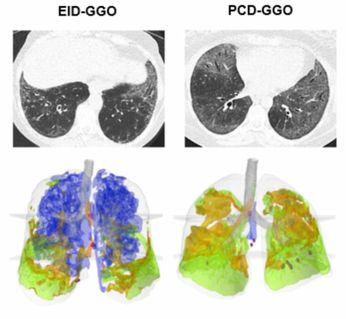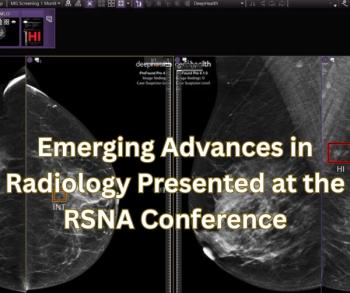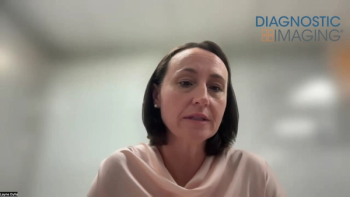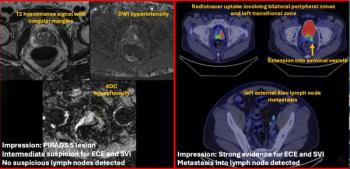
Emerging Research and News in Breast Imaging — October 2025
Catch up on the most well-viewed breast imaging content in October 2025.
New research in breast imaging in October ranged from emerging findings with digital breast tomosynthesis (DBT) and artificial intelligence (AI) to the impact of initial concordance between radiologist and AI interpretation on future breast cancer risk. With this in mind, let’s take a closer look at our breast imaging content coverage from October.
What Emerging Research Reveals on False-Negative Findings in Mammography
A large-scale analysis of over 38 million mammography exams conducted between 2010 and 2022 identified several patient and facility factors independently associated with higher rates of false-negative (FN) assessments.1,2
A personal history of breast cancer was linked to over a 3.6-fold higher likelihood of an FN assessment. Researchers also affirmed the significant impact of breast density upon diagnostic performance.
Racial disparities persist with Black women and women of mixed or other races experiencing 12 percent and 17 percent higher rates of FN diagnostic mammography assessments, respectively, when compared to White women. The study authors noted these differences may be reflective of variations in access to supplemental breast cancer screening and primary care.1,2
Can AI Enhance Risk Stratification in Breast Imaging?
In a retrospective study involving over 134,000 women who had triennial screening mammograms,
Significantly, women in the highest 20 percent of Mirai risk scores accounted for 42.4 percent of interval breast cancers, suggesting its utility in identifying patients who may benefit from supplemental imaging or a shortened screening interval. This predictive ability was maintained across different age and breast density categories, according to the study authors.3,4
Recent research on AI for digital breast tomosynthesis (DBT) indicates that AI scores may provide insight into tumor biology. In an interview with Diagnostic Imaging,
For screening mammography,
Expanding the Clinical Impact of Mammography Screening with Cardiovascular Risk Assessment
Radiologists can expand their role in preventive care through opportunistic screening. The recently launched Mammo Enhance Heart program by Radiology Partners emphasizes mammography detection of breast arterial calcification (BAC), an established biomarker for cardiovascular disease risk.8
In a recent interview with Diagnostic Imaging, Arthy Saravanan, M.D., noted that Mammo Enhance Heart utilizes an FDA-cleared AI tool to enhance the sensitivity of BAC detection and suggested that it may be beneficial for monitoring changes in these calcifications over successive screenings.
Final Notes
The integration of advanced AI models into mammography offers tools for more individualized risk assessment, improved cancer characterization, and the potential to reduce FN rates, particularly in challenging cohorts such as women with dense breasts. Simultaneously, programs that leverage the inherent diagnostic information available in mammograms, like BAC detection, position radiologists to play a broader role in early recognition of critical conditions such as cardiovascular disease, the leading cause of death in women.
References
- Oluyemi ET, Grimm LJ, Goldman L, et al. False-negative screening and diagnostic mammograms in the National Mammography Database from 2010 to 2022. AJR Am J Roentgenol. 2025 Oct 22. doi: 10.2214/AJR.25.33636. Online ahead of print.
2. Hall J. Large mammography study examines contributing factors with higher false-negative rates. Diagn Imaging. Available at:
3. Rothwell JWD, Rogers P, Payne NR, et al. Evaluation of a mammography-based deep learning model for breast cancer risk prediction in a triennial screening program. Radiology. 2025 Oct;317(1):e250391. doi: 10.1148/radiol.250391.
4. Hall J. Predicting interval breast cancer risk: can a mammography deep learning model have an impact? Diagn Imaging. Available at:
5. Hall J. Mammography research: can adjunctive AI for DBT provide insight into tumor biology with breast cancer? Diagn Imaging. Available at:
6. Kim EY, Park EK, Kim M, et al. Radiologist and AI concordance in screening mammography and association with future breast cancer risk. Radiol Artif Intell. 2025 Oct15:e240804. doi: 10.1148/ryai.240804.
7. Hall J. Mammography study shows elevated future breast cancer risk with initial concordance of radiologist and AI interpretation. Diagn Imaging. Available at:
8. Hall J. A closer look at the Mammo Enhance Heart program: an interview with Arthy Saravanan, MD. Diagn Imaging. Available at:
(Editor’s note: This article was written with artificial intelligence and reviewed by human editors for accuracy.)
Newsletter
Stay at the forefront of radiology with the Diagnostic Imaging newsletter, delivering the latest news, clinical insights, and imaging advancements for today’s radiologists.




























